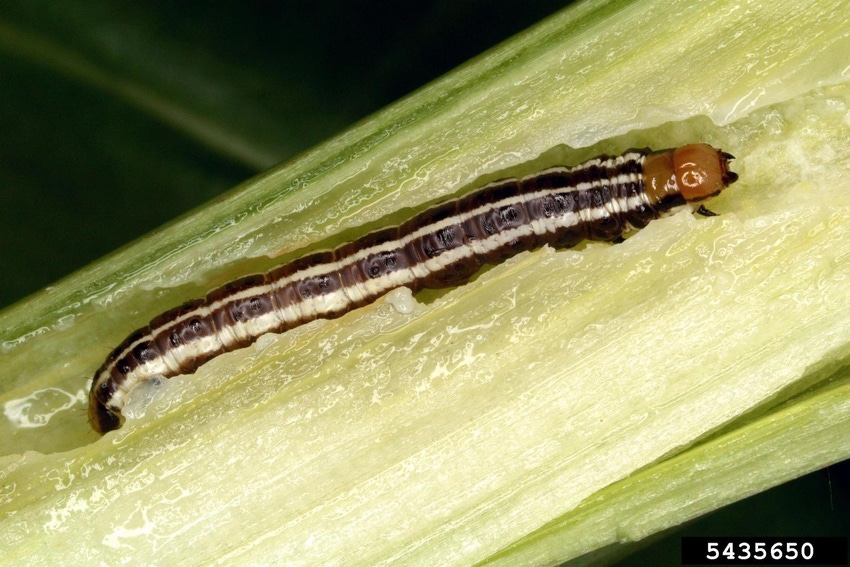June 2, 2014

Corn growers should start scouting for common stalk borer, say experts at Iowa State University and University of Nebraska-Lincoln. Scouting for migrating larvae in corn should begin now to make timely treatment decisions, says Erin Hodgson, Iowa State University associate professor of entomology.
Common stalk borer larvae are distinctive in appearance. Young larvae (Figure 1a) are brownish-purple and have three prominent longitudinal white stripes at the front and rear ends of the body. The stripes are interrupted at mid-body by a solid dark purple to black area on the third thoracic segment and first three abdominal segments. Fully grown larvae do not have these characteristic markings and are uniformly dirty gray (Figure 1b). Fully grown larvae can be 1 1/2 to 2 inches long.
Stalk borer larvae injure corn plants in June and early July. They feed on leaves in the whorl and then tunnel into the stalk, or they burrow into the base of the plant and tunnel up through the center of the stalk. Leaf feeding alone does not cause economic damage.
Tunneling into the stalk can result in deformed or stunted plants that may not produce an ear. Severely damaged plants can die. Plants attacked at earlier growth stages tend to be more severely injured. A single stalk borer larva may attack more than one plant if the first plant does not support the larva as it increases in size.
Damage caused by feeding in the whorl will first appear as irregular rows of holes in the unfolding leaves. These irregular rows of holes will be much larger and more ragged than those caused by whorl-feeding of first generation European corn borer larvae. In severe cases an infested plant will have a very ragged appearance, with abnormal growth habits such as twisting, bending over, or stunting. If the feeding injury to the central part of the plant is severe enough, the whorl will appear dead while the outer leaves will be green and apparently healthy. This condition is commonly called "dead heart."
Scouting and management
Check corn plants bordering grassy areas to determine the percentage of plants with stalk borer injury when 1,300-1,400 degree days (41°F base) have accumulated since January 1, says Bob Wright, UNL Extension entomologist.
When scouting, examine several sets of 10 plants. Look for feeding damage and dissect damaged plants to see if live larvae are present. If weedy grasses were common throughout the field in the previous year, the whole field may need to be scouted for common stalk borers.
Stalk borer infestations are more likely found in corn surrounded by giant ragweed. Female moths prefer to lay eggs in weedy areas in August and September, so minimizing weeds in and around corn during that time will make those fields less attractive. Using herbicides to kill spring weeds can force stalk borer larvae to infest young corn plants. Long-term management requires controlling grassy edges around corn so that mated females will not lay eggs in that area during the fall.
Fields with persistent stalk borer infestations should be monitored every year. Applying insecticides to infested corn is not effective because the larvae are protected once inside the stalk. Instead, target foliar applications to larvae as they migrate from grasses to corn. Look for larvae inside the whorls to determine the number of plants infested. The larvae are not highly mobile, and typically only move into the first four to six rows of corn. Look for new leaves with irregular feeding holes or for small larvae resting inside the corn whorls. Larvae will excrete a considerable amount of frass pellets in the whorl or at the entry hole in the stalk. Young corn is particularly vulnerable to severe damage, but plants are unlikely to be killed once reaching V7.
To be effective, insecticides must be applied before common stalk borer larvae have entered the stalk. In cases where stalk borers begin feeding on grassy weeds or other vegetation in field edges, control is most effective if timed between 1,400 and 1,700 degree days (base 41°F), which corresponds to the first half of the period when stalk borers are migrating from weedy hosts into corn. If the infestation is restricted to the field margin, use a border treatment.
Insecticides may be mixed with fast-acting herbicides being used to burn down early season weeds, or applied several days after use of slower-acting herbicides. Check the label for compatibility of different insecticide and herbicide mixtures.
Read more about stalk borer management from Iowa State University and University of Nebraska, Lincoln.
 You should also read:
You should also read:
Cover crops don’t rob corn, soybean yields
You May Also Like




